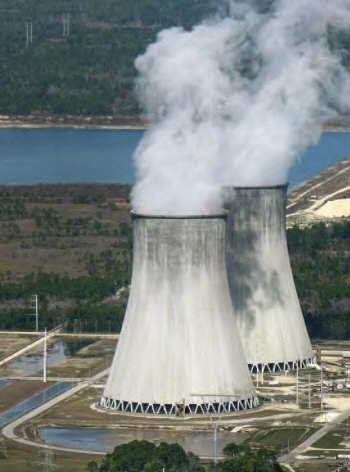SEJournal Online is the digital news magazine of the Society of Environmental Journalists. Learn more about SEJournal Online, including submission, subscription and advertising information.
Inside Story
Ivan Penn is a utility, energy and consumer reporter for the Tampa (FL) Bay Times who has won numerous national and local journalism awards. In the last several years, he has written on nuclear power, including the closing of the Crystal River Nuclear Plant, problems with cooling tubes at another facility and the risk to ratepayers for new nuclear power generation in Florida. Penn spoke recently to SEJournal’s “Inside Story” Editor Beth Daley about his work. See more of Penn’s work here.
 |
|
Cooling towers at Crystal River nuclear plant in Florida. Duke Energy announced it will permanently close the crippled plant that has been shut down since late 2009. Photo by Maurice Rivenbark, Tampa Bay Times |
SEJournal: Why did you begin to take such a focused look at nuclear power in recent years?
Ivan Penn: Two issues arose with our utility, Progress Energy (now Duke Energy): First, there were questions about the company's only nuclear plant in Florida, Crystal River 3, and cracks in the reactor's containment building. Would the damage force the utility to permanently close the facility? Who was at fault? Second, the company wanted to build two new reactors for $24 billion, the most expensive nuclear project in U.S. history. Was this in the best interest of consumers? That's where we began.
SEJournal: How do you sort out truth among advocates, regulators and industry officials in covering nuclear power and energy in general?
Penn: Everyone has their spin and it does become dizzying at times. We have focused largely on the economics, decision-making and indisputable facts. What does the law or regulation say? So, in the case of wear in steam generator cooling tubes at the St. Lucie nuclear plant, it isn't simply a matter of safety per se, as all of the parties want to argue (whether it's advocates warning of a potential hazard or the utility and the U.S. Nuclear Regulatory Commission insisting the operation remains safe). We can measure the amount of tube wear against what the regulations say about taking a tube out of service due to excessive wear and the implications of that: Whether the plant is safe at that level or not. The regulation/law is what it is.
SEJournal: Your writing is often sharp and simple, despite the complexities of what you cover. Are there any tips you have for SEJ reporters on how to achieve that clarity?
Penn: Good editors make the world of difference and I have two very good ones. They remind me of some of the basic things we always talk about as journalists: keep the jargon out of the story. For stories involving technical and scientific information delivered by some really smart people, it is hard – but we must – resist allowing them to dictate to us how to write the story. When there was a crack in the Crystal River nuclear plant, the utility kept insisting I call it a "delamination" or "separation in the concrete." Only engineers understand delamination, but the reality is a "separation" is a crack.
SEJournal: What is the most challenging aspect of covering energy and utilities?
Penn: I'm covering all these really smart people – engineers,accountants, lawyers and economists – and I am challenging their arguments, data and conclusions. It's daunting. The biggest challenge is to figure out what they are not saying or accurately portraying issues that could harm consumers.
SEJournal: Your analysis questioning officials’ claims that nuclear power was financially beneficial for ratepayers was enlightening. Tell us about one of the main obstacles of that story and how you overcame it.
Penn: The major obstacle was to build our own economic model to compare the cost of the proposed nuclear plant to a comparable natural gas facility. We kept it local because, again, it was the most expensive nuclear project in U.S. history. We studied ratemaking models and I consulted accountants, economists, engineers and lawyers as I put together our model to ensure it was sound.
SEJournal: What in the energy arena is not being covered well and do you have any advice for journalists who want to start reporting on the beat?
Penn: Utility companies and state regulatory commissions are not being seriously covered much at all these days. Most everyone receives an electric bill. It's hundreds, even thousands of our dollars in a household every year. This isn't really revelatory: start following the money. Who's paying? How much? And where is it going?
“Inside Story” editor Beth Daley is reporter and director of partnerships at the New England Center for Investigative Reporting, a nonprofit newsroom based at Boston University and affiliated with WGBH News.
* From the quarterly newsletter SEJournal, Summer 2014. Each new issue of SEJournal is available to members and subscribers only; find subscription information here or learn how to join SEJ. Past issues are archived for the public here.













 Advertisement
Advertisement 



